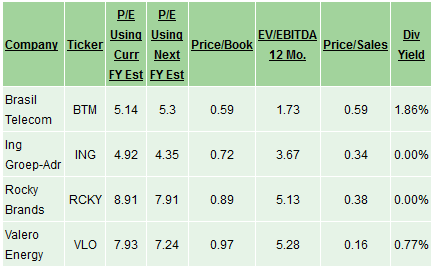Some of the best investments are when you can find a firm for which expectations are very low, but which end up doing better than expected. The absolute performance does not have to be great, just not as awful as everyone expected.
Think of stocks as sports teams: Which “stock” do you think would do better if both reached the wild card round of the baseball playoffs this year, the Yankees or the Mets? Yankee fans tend to see the season as a bust if they don’t at a very minimum play in the World Series. Mets fans still re-live the glory days of 1969.
Better to Buy Cheap (In the Long Run)
Firms for which the market’s expectations of the future are low tend to be very cheap statistically. There is a very large body of research that suggests that over time you do much better buying cheap firms than expensive ones, even if the expensive ones seem to have the hot products and the buzz around them.
However, you can also get stuck in a “value trap” — a stock that is cheap for a reason and simply sits at low multiples for long periods of time without much improvement in the underlying metrics. The key is to try to find cheap stocks where the underlying fundamentals are improving. Then, not only do you enjoy the underlying growth, but you also tend to get a multiple expansion. More often than not, it is the multiple expansion that provides the biggest part of the return.
One of the best indications of improving underlying fundamentals is a positive earnings surprise, coupled with rising earnings estimates. Those are the factors that drive the Zacks Rank. Only the best 5% of all firms earn the Zacks #1 Rank.
Measuring Value
The most common measure of value is the P/E ratio. It is not perfect, especially for firms with volatile earnings streams (such as cyclical stocks). If one were to base all value on the P/E ratio, then any company that runs a loss in a given year would be “properly” valued at zero. Clearly, that is not the case. Still if I were forced to pick only one measure of value, it is probably the one I would go with.
Fortunately, that is not the case and there are other measures of value to look at. For this post I wanted to find the Zacks #1 Ranked firms that were cheap across multiple measures of value.
After the P/E ratio, the most common measure of value is Price-to-Book Value (P/BV). Book value is the value of all of the firms assets, minus all its liabilities, per share. I have always found this measure to be asymmetrical, with a low multiple almost always indicating the company is cheap (particularly if you use tangible book value, subtracting out the goodwill on the balance sheet).
However, a high price-to-book value is not as good a gauge of a firm being overvalued. If a firm is selling below tangible book value, it means that theoretically it could be worth more dead than alive.
At the very least, that provides a good margin of safety for your investment. You are not looking for the company to simply shut down, and all the assets sold off and returned to you, but knowing that if that happened that you would get more than your investment back puts a nice floor under the shares. Unfortunately, I could not screen on tangible book for this post, so we will have to make do with stated book value.
Another common measure of value is to look at the stock price relative to the top line, not the bottom line. This measure is more useful when looking at the company relative to its own history, or its industry peers than it is across the market as a whole. Some industries, especially those with high net margins, will tend to sell for much more than their annual sales per share (drug companies for example), and those that are in high turnover, low margin businesses (e.g. grocery stores) will tend to have low Price to Sales (P/S) multiples. Still, all things considered, it is better to have a low P/S ratio than a high one.
Enterprise Value to EBITDA
The final measure of value I looked at is sort of a variation on the P/E ratio, and is a favorite of the private equity crowd. It is the enterprise value to earnings before interest, taxes, depreciation and amortization multiple (EV/EBITDA). If you were to buy the entire company and take it private, not only would you have to buy all the outstanding shares, but you would also be assuming whatever debt the company had. You would also own whatever cash the company had in the bank.
The enterprise value is what it would cost to buy the whole firm at current prices, the market capitalization, plus long-term debt, minus the cash and short-term investments on the balance sheet.
Why earnings before all that stuff? Well, it is the amount of cash the company is generating that could be used to pay off debt. Yes over the long term, depreciation tends to be a real expense, as equipment gets worn out and needs to be replaced, but in the short term, you can hold things together with duct tape and bailing wire and use that cash to pay off debt.
In some industries, such as REITS, depreciation is largely just an accounting fiction, as the value of existing buildings tends to rise over time, not deteriorate.
Amortization is a close cousin of depreciation. Interest is tax deductible for companies. If you were to lever up and take a company private, in the short term most of the earnings would be taken up by interest payments, and the tax bite would be negligible.
Finding the Cheapest of the Cheap
In an effort to find the “cheapest of the cheap” among the firms that currently hold the Zacks #1 Rank, I imposed very stringent criteria to each of the valuation metrics. The P/E had to be below 9 based on this year’s earnings and below 8 on next year’s earnings. Both P/BV and P/S had to be below one, and the EV/EBITDA ratio had to be below six.
Only four companies were able to meet these criteria, and they are very different companies. The only thing they seem to have in common is that they look extremely cheap and have Zacks #1 Ranks. (prices are as of the close 5/24/11). Firms that are this cheap are going to have some warts on them, but it is the very fact that they are cheap that provides your margin of safety:
Brazil Telecom (BTM) is, as its name suggests, a Telecommunications utility in Brazil. It is a bit heavy on the land-line side, but does have wireless and Internet access as well. The Brazilian economy is booming, and this is a relatively low-risk way to get in on that growth.
ING Groep (ING) is a massive a financial services company, provides banking, investment, life insurance and retirement services worldwide, but based in the Netherlands. It is extremely well diversified, both by product line and by geography. It does, however, have some exposure to the debt problems in the periphery of Europe.
Rocky Brands (RCKY) is a footwear manufacturer, mostly making boots under the Rocky and Dickie’s brands. They are also a major supplier of boots to the U.S. Military. Fashion can be fickle, but demand for army boots is pretty stable and is not subject to the whims of the fashion world. This is by far the smallest of the four firms that pass the screen.
Valero (VLO) is the largest independent oil refiner. It owns and operates 14 oil refineries with a combined capacity of 2.6 million barrels per day located in the United States, Canada and Aruba; and 10 ethanol plants situated in the Midwest, with a combined production capacity of 1.1 billion gallons per year. It markets the gasoline through a network of 5,800 gas stations. Historically, upstream has been a better business than downstream in the oil industry, but at these prices, Valero looks very attractive.
As always, a screen should be only the first step in your investment research. These stocks, though, have the very appealing combination of being extremely cheap on a statistical basis, and are starting to get some estimate momentum behind them. Historically, that has often proved to be the path to some very large gains.

VALERO (VLO): Free Stock Analysis Report
- Bulenox: Get 45% to 91% OFF ... Use Discount Code: UNO
- Risk Our Money Not Yours | Get 50% to 90% OFF ... Use Discount Code: MMBVBKSM
Disclaimer: This page contains affiliate links. If you choose to make a purchase after clicking a link, we may receive a commission at no additional cost to you. Thank you for your support!




Leave a Reply